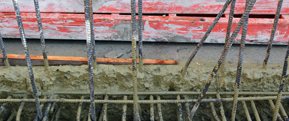 This is number two in a series of three posts on joints. Check out yesterday’s here.
This is number two in a series of three posts on joints. Check out yesterday’s here.
For joints to be effective in mitigating uncontrolled cracks, they must be correctly designed and built. Joint depths should be appropriate for the thickness of the concrete. For example, a crack inducement joint should have a depth that is approximately one-quarter of the concrete’s thickness while isolation joints should extend the full depth of the slab. Joints should also be spaced no further apart than 30 times the concrete thickness. Proper tools should be used in forming joints, such as saws, handfinishing tools or pre-molded strips. There are dozens of considerations that should be followed in order to produce reliable and successful joints. But there is one that is the most important of them all: waterproofing.
While joints go a long way in making concrete stronger over the long run, they also represent the most vulnerable part of the structure. The challenge lies in the intrinsic design of joints – the physical separation between concrete slabs creates an exposed area where water ingress will happen. So it’s not a matter of if the joint will leak, but when.
Leaking concrete joints can not only result in expensive repairs and inconvenient renovations, but can also lead to severe health hazards. From mold and fungus growth triggered by incoming moisture to waterborne contaminants entering the structure, leaking joints can be unsafe for structures and the people that use them.
Coming up tomorrow – Joint Waterproofing Options.






